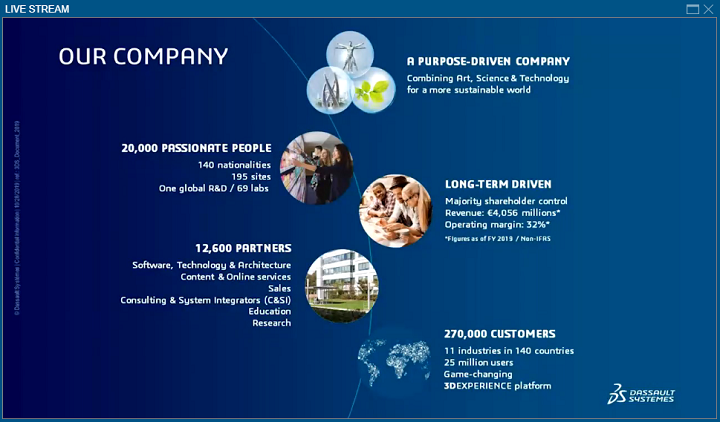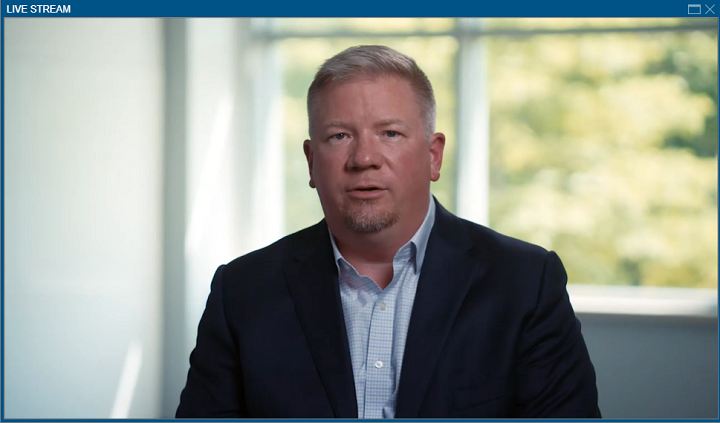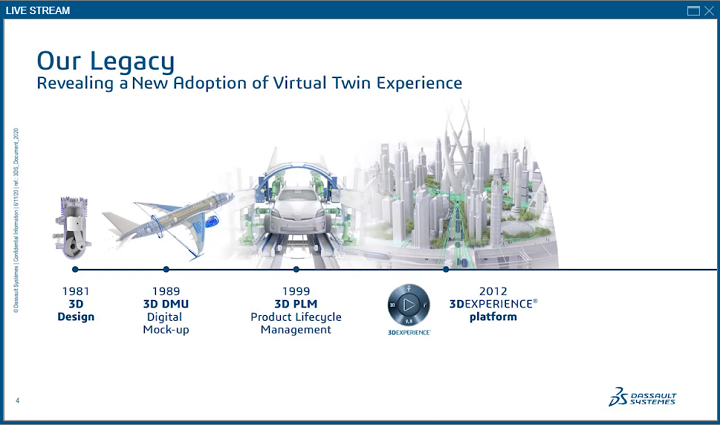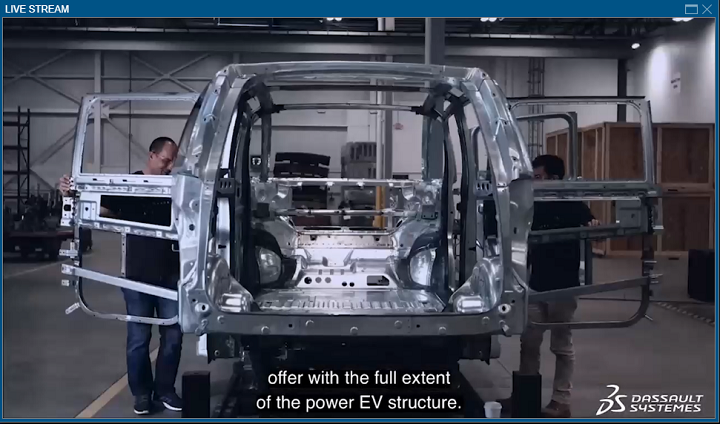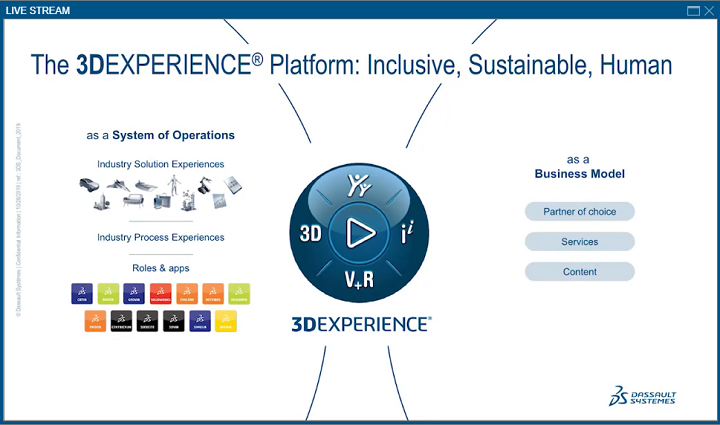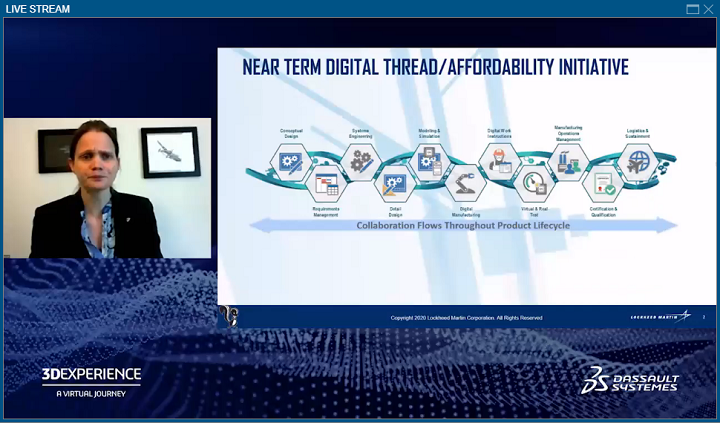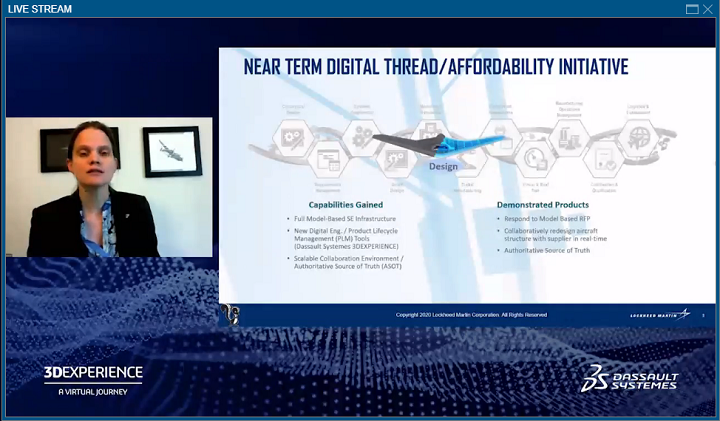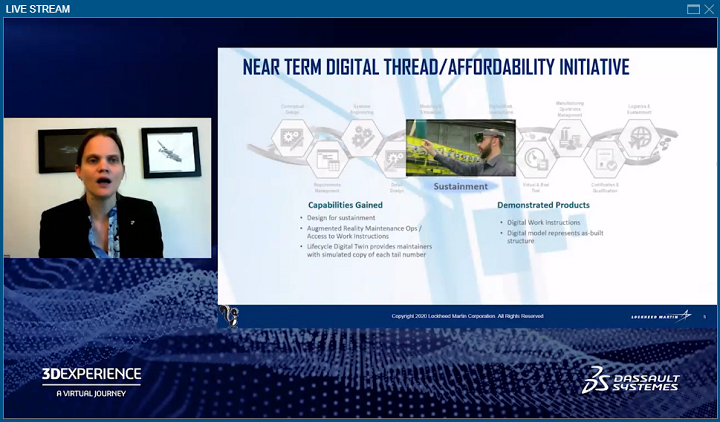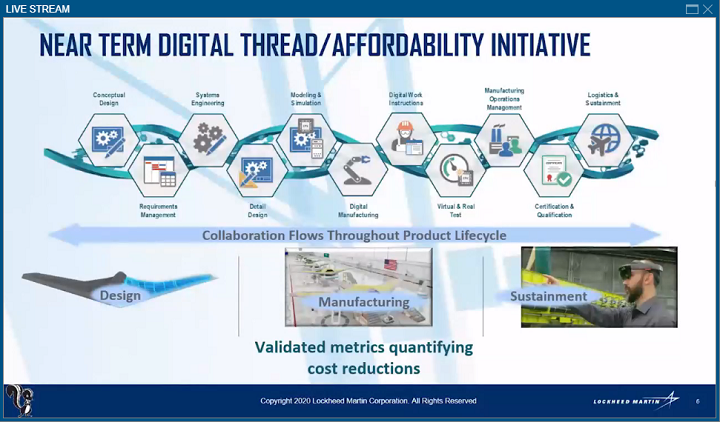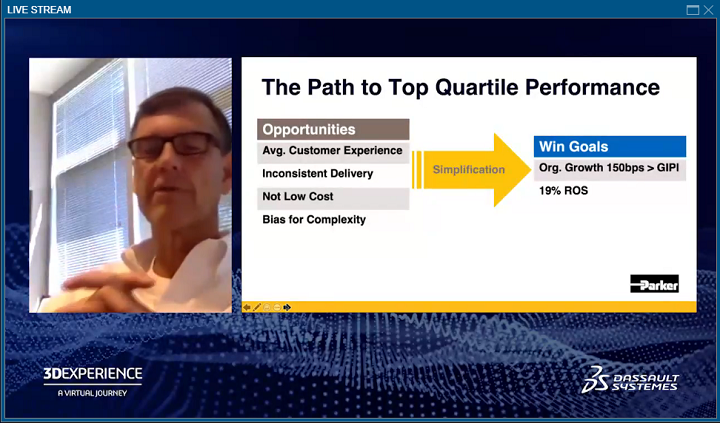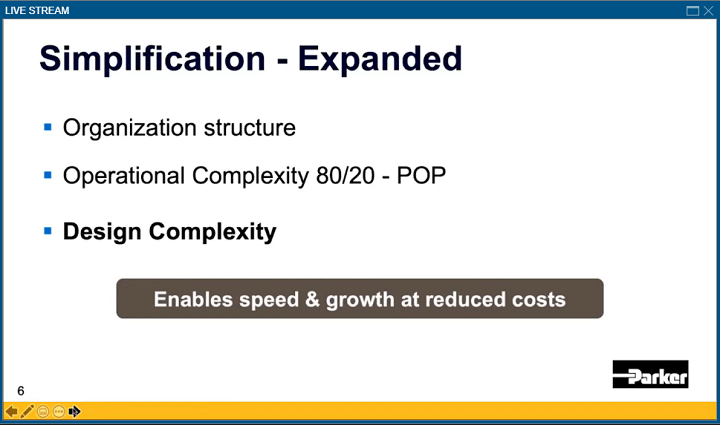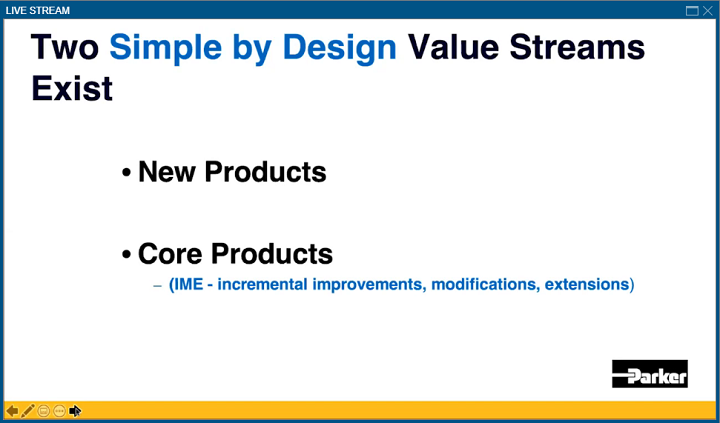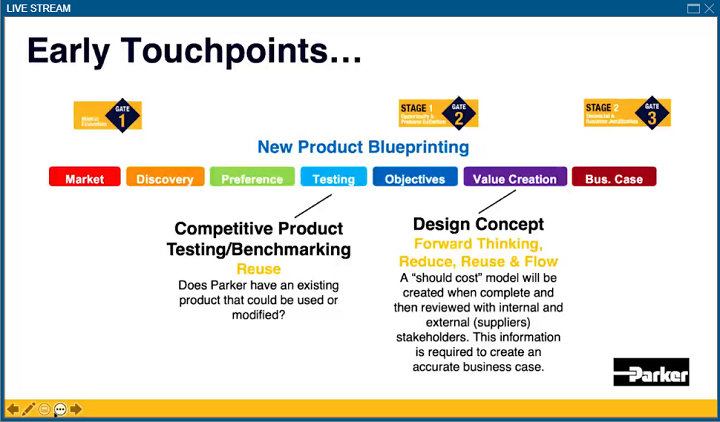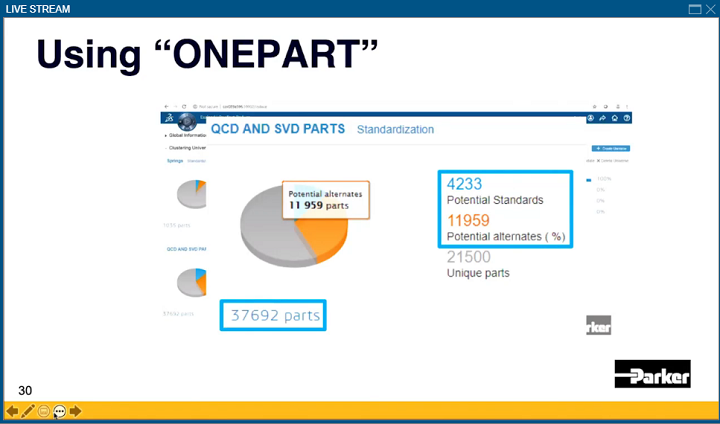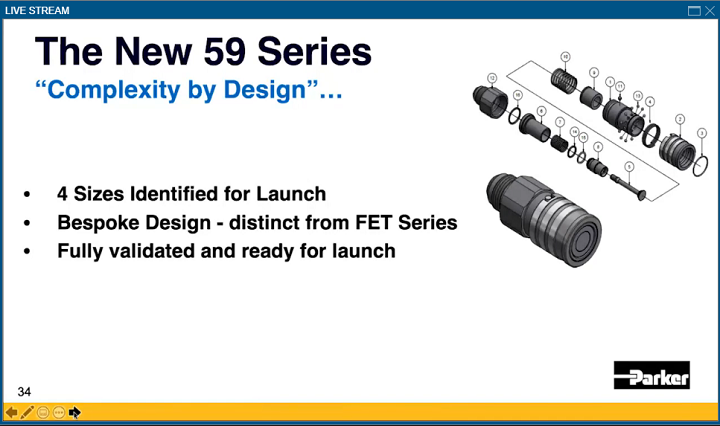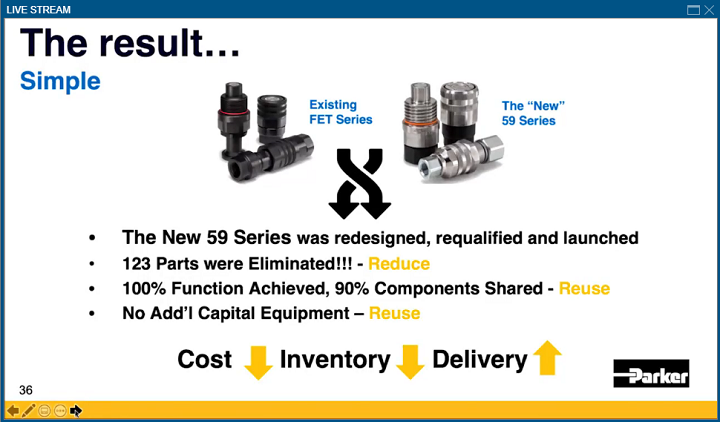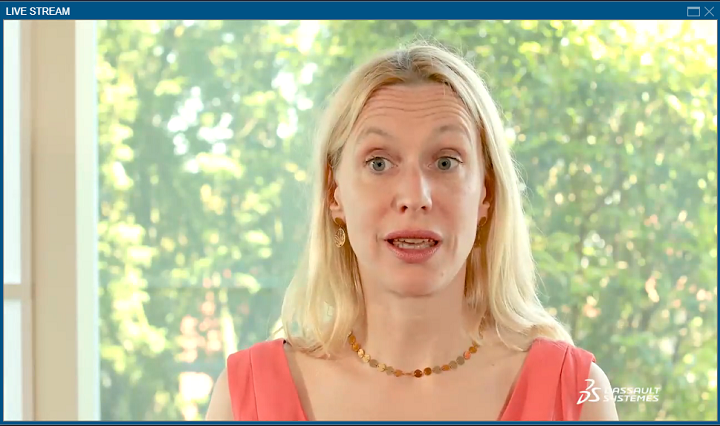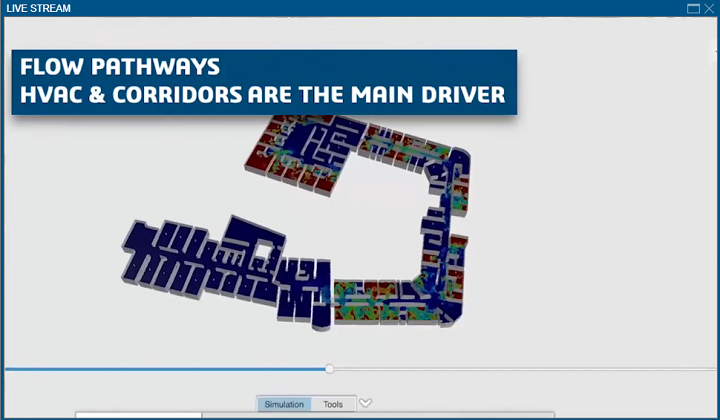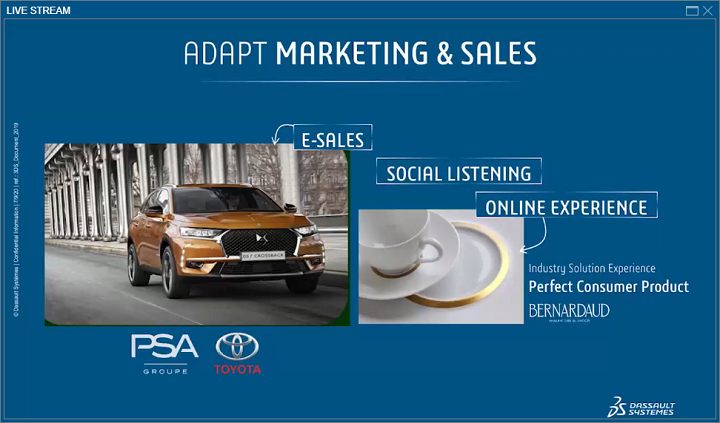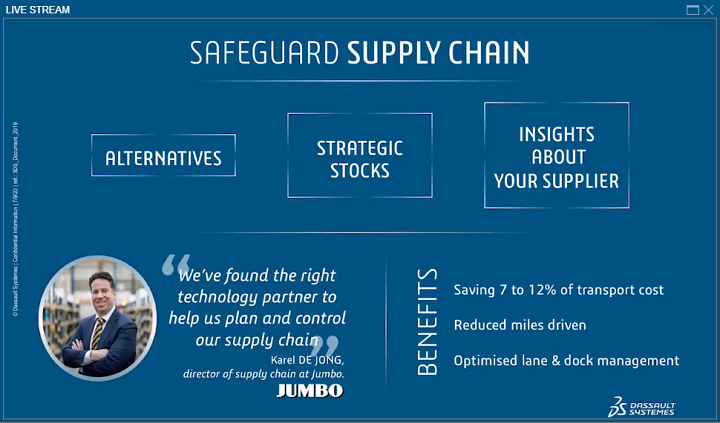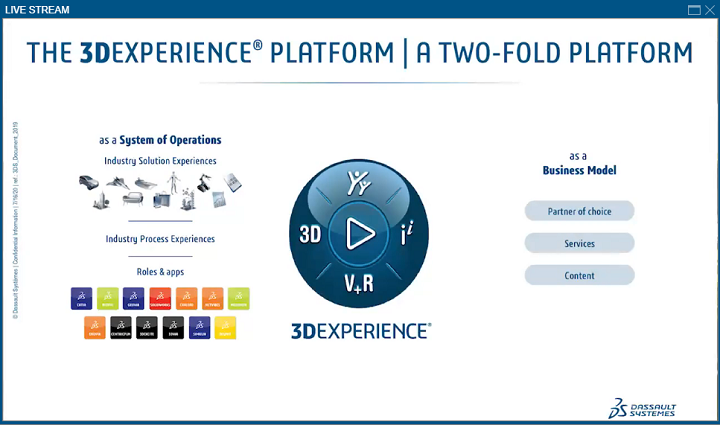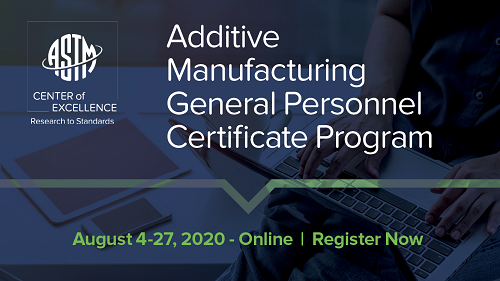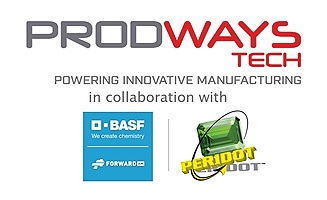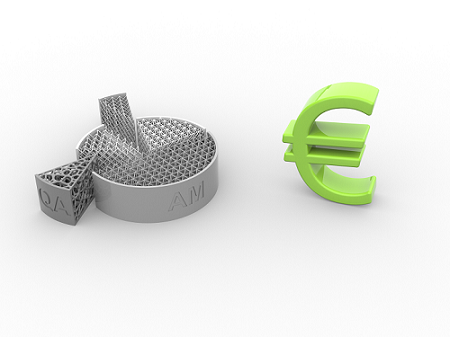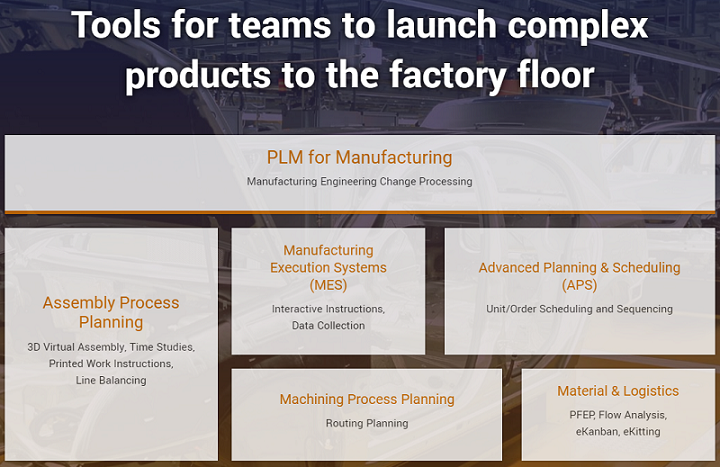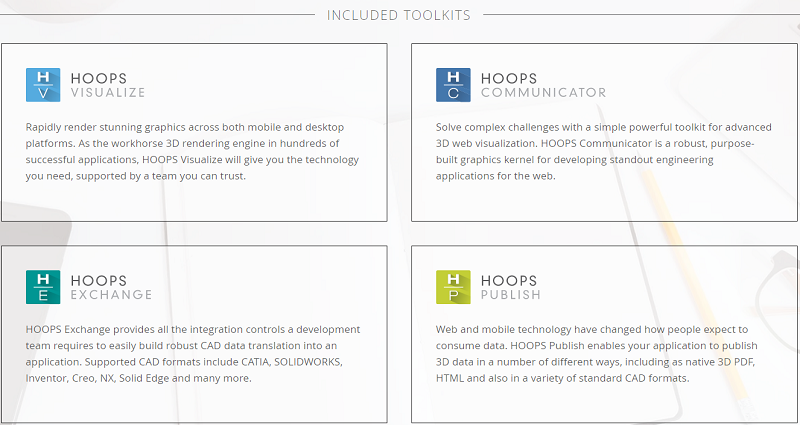You’re Using Too Many Software Applications to Run Your 3D Printing Business
3DEXPERIENCE: A Virtual Journey, Part 1
Due to the ongoing COVID-19 crisis, this year’s 3DEXPERIENCE Forum by Dassault Systèmes had to be re-imagined as a virtual event, just like so many other conferences. At 1 pm EDT on July 29th, nearly two months after the in-person event was meant to have taken place in Florida, the company began the live stream of the Plenary Session for “3DEXPERIENCE: A Virtual Journey,” a series of digital programming that replaced the annual North America customer event.
Unfortunately, the webinar seemed to be having issues, which continued on and off over the next two hours of the live stream, so I missed pieces here and there. Technical difficulties happen all the time at live events, too, so the only real difference here was that I couldn’t raise my hand and say, “I’m sorry, the audio and picture cut out, could you repeat that please?” Luckily, Dassault had the webinar up to view on-demand the very next day, so I was able to go back and check out the parts that I had missed.
Erik Swedberg, Managing Director, North America, Dassault Systèmes, got things started with his segment on “Business in the Age of Experience: Challenges and Opportunities for North America,” which focused on manufacturing and supply chains, and why companies looking to transform, some sooner than they’d hoped due to the pandemic, should “invent the industry of tomorrow,” rather than trying to digitize the past or the present.
“Yesterday, businesses focused on automation of the manufacturing system; this is Industry 4.0. Today, many industrials are digitizing the enterprise system. It’s not enough. You need to create experiences. Tomorrow, the game changers will be those with the best developed knowledge and know-how assets. Why? Simple. Because the Industry Renaissance is about new categories of new industrials creating new categories of solutions for new categories of consumers,” Swedberg said.
He mentioned Tesla and Amazon, companies in Silicon Valley working to create autonomous vehicles, and fab labs creating and printing smart, connected objects.
“The 3DEXPERIENCE platform is a platform for knowledge and know-how—a game changer, collaborative environment that empowers businesses and people to innovate in an entirely new way,” he continued. “Digital experience platforms for industry, urban development, and healthcare will become the infrastructure for the 21st century.”
Swedberg explained how 3DEXPERIENCE can allow any business to become social, by connecting employee innovation into the system where the company’s products are designed. This was a common theme today, which you’ll be able to see later.
He also explained that, with Dassault’s 13 brand applications—such as SIMULIA, CATIA, and SOLIDWORKS—the company can serve a wide variety of industries, helping its customers on their journey to invent tomorrow’s industry.
“In summation, we are in the experience economy, the Industry Renaissance is here, and world events are accelerating the need for digital transformation. As the world changes, we will partner with you for success,” Swedberg concluded. “We have the people and the insights to help you on your journey.”
Dassault’s Vice Chairman & CEO Bernard Charlès was up next, speaking about “From Things to Life.” He first said that he hoped no one on the live stream, or their loved ones and colleagues, had been impacted by the COVID-19 crisis.
“We’ve gone through a tough time, all of us. And we are with you, and we are learning a lot also from the crisis,” Charlès said.
Even though I’ve worked from home for nearly four years now, other aspects of my life have been turned upside down in the last few months, and I felt a kind of solidarity whenever the session’s speakers brought up how all of our lives, and our industry, have changed. Charlès also congratulated everyone signed into the live stream on working together, and continuing to innovate, during the pandemic; the continuing health crisis was another theme that threaded throughout the plenary session.
He said that the 3DEXPERIENCE platform is about inclusiveness, “because it means ideas and people connecting.” He shared some of the work that 3DEXPERIENCE users had accomplished during the recent and varied quarantines, such as creating respirators, improving logistics, and working to make the quality of airflow in hospitals better. He said that all of these projects were done on the 3DEXPERIENCE cloud.
“So many of you accelerated the cloud implementation, to be able to work from anywhere, especially from home, during confinement time.”
He mentioned that we are moving from a product economy to an experience economy, and that, in the long run, companies will continue to produce, and maintain ownership of, products and services throughout the life cycle, while their customers will get to enjoy the experience.
“That will accelerate innovation for a sustainable world,” Charlès said.
Next, he talked about a few companies that have been using the 3DEXPERIENCE platform for interesting projects, like California-based Canoo, which dreams about refining urban mobility with an electric vehicle that can be used as a service or subscription, rather than being owned by individuals.
In order to create innovation, Charlès said, you need to be sure that your digital platform will work, and Canoo stated that 3DEXPERIENCE hit the mark here, helping to speed things up in the product development process.
He then talked about Arup, a company that’s using the 3DEXPERIENCE platform to create a virtual Hong Kong for city planning purposes. Arup is working to make Hong Kong a smart city, and the platform is helping the company in this endeavor; for example, Arup and Dassault just completed a project called the Common Spatial Data Infrastructure Built Environment Application platform…say that three times fast.
Finally, Charlès explained that the role of life sciences is to “protect what we care about,” and said that industry pioneers are coming up with new and different ways to diagnose and care for people. He stated that creating new healthcare experiences is a complex project, because it means converting big data into smart data and simulating real world situations in a virtual world. Luckily, 3DEXPERIENCE can help with this.
“3DEXPERIENCE…is a system of operation, because the platform can help you run your business, and the platform should also help you invent a new business model,” Charlès concluded. “The common values across all the industries we serve is putting the human at the center of everything we do.”
Next, Renee Pasman, Director of Integrated Systems at Skunk Works for Lockheed Martin, provided an overview of using the digital thread, and the 3DEXPERIENCE platform, for the product lifecycle, “and how Lockheed Martin is leveraging it to drive increased affordability, efficiency and collaboration throughout the lifecycle.”
“…Our projects cover the entire product life cycle that you might imagine from an aerospace and defense type of program, all the way from conceptual design through modeling and simulation, manufacturing, to sustainment and end of life,” she explained. “And one key part of the Skunk Works culture in the last 75 years has been very close collaboration across all of those areas. What we’ve learned as we have started this digital thread initiative is that by giving our workforce these latest tools, we’ve been able to make that collaboration easier, to be able to make it go faster, to be able to bring data in sooner, make better decisions, see what the impacts are of those decisions, and use that to guide where we are going.”
She explained that the product lifecycle “really starts with design,” and said that by starting this new Near Term Digital Thread/Affordability initiative and giving its workforce the 3DEXPERIENCE tools, Skunk Works has learned that collaboration is faster and stronger, and that we “make better decisions to guide where we’re going.”
We’ve all heard about this issue before—there are two versions of an important product document, and some people update one, while others update the other, and no one has a clear idea of which version is correct and most up-to-date. It’s frustrating to say the least. But Pasman noted that by using the 3DEXPERIENCE product lifecycle management platform, “we’re starting to see efficiency benefits now.”
Pasman also said that the Skunk Works team has learned something “unexpected” with the platform, and that’s the social collaboration it provides, which allows users to “make changes with a level of certainty.”
“We hadn’t necessarily focused on this area, but our teams really used this environment to collaborate better, and found it to be very useful to have all information in that single source of truth.”
Pasman also noted the usefulness of having a life cycle digital twin, as it “allows us to tie it all the way back not just to manufacturing but actually back into design, and making sure the data flows in the digital twin seamlessly.”
“I think if you talk to maintainers or sustainment and users, there’s a lot of time spent putting data into different systems. By making it easier to do that, it allows people to focus on the hard parts of their job, and not just the data entry parts,” she explained. “Collaboration between different areas and getting data flowing is where we see a lot of the benefit from 3DEXPERIENCE, from affordability and product quality perspectives. We’re focused now on how to take the next step in this journey and improve schedule and affordability to fit into the market space that we are working in today. That’s where a lot of the work from our digital thread initiatives have been focused.”
Next up, Craig Maxwell, the Vice President and Chief Technology and Innovation Officer for Ohio-based motion and control technologies leader Parker Hannifin, spoke about “Simple By Design.” The multinational company has been integrating some of the tools that Dassault has been developing over the past few years, which has been valuable to the company.
“When we look at any enterprise or business, we saw these as opportunities that would manifest themselves as complexity,” he said in reference to the image below. “An average customer experience, which might be the ability to ship on time, with high and consistent quality. Of course, inconsistent delivery would manifest itself as complexity. High cost would be complexity…and then all of this would beget complexity in its many forms.”
He said that all of these complexities can add up to new opportunities to take the company on the path to high performance. Maxwell also explained that the company’s traditional simplification efforts had revolved around design and organizational structure, explaining that 80% of any business’s profits and sales come from 20% of its portfolio.
“So by slicing and dicing that, could we eliminate complexity? The answer is a resounding yes,” Maxwell said.
He explained that 70% of a product’s cost is design, while 30% is labor and overhead, like lean manufacturing and the supply chain. The key is to spend less time on L&O, or conventional simplification, and work harder to reduce business complexity in that 70% design range. He said there are hundreds and thousands of decisions made on the L&O side, which, while easier to change, had a more limited impact on the long life cycles of their products.
“There were processes in place that we felt could address that reactively, not proactively,” he said.
With design, the decisions made were “relatively few and quick,” even though they could make a significant impact, because they would be difficult to change, mainly due to expensive tooling.
“We believe that if we can address design complexity, it would enable us to move faster and to grow by taking market share,” Maxwell said.
He explained that the cross-functional team Parker Hannifin set up to address “new” product complexity in a proactive way knew early on that there are two different value streams of Simple by Design.
“New products, for sure, but also core products,” he said. “If you look at where the money is, new products get a lot of attention, but our business is core products…they’re undergoing revisions constantly because our customers are asking for things that are different.”
The team decided to tackle new products first, and spent a lot of time working on design-related objectives, which is where they thought “a lot of the complexity and cost was being created.” He explained that the team wanted to keep the customer at the center of their attention, figure out what their pain points were and what they wanted, and get rid of the things that didn’t add value.
“The first principle of Simple by Design is design with Forward Thinking. With that deep customer engagement, anticipate what your customers are going to ask for in the future,” he explained. “Are there things we can do to the design of the product that, without increasing cost, that will allow us to make changes to it at a later date? The second principle is Design to Reduce, so to reduce complexity, can we reduce the number of new parts that we have, can we reduce the number of new suppliers we have? Can we eliminate proprietary materials that might be hard to come by?
“Design to Reuse – can we reuse parts that already exist? Why do we need to invent new when we’ve already got very similar or exactly what we need released into the system…and then finally, if we do the first three, we should see flow in the factory. We should not see the kind of bottlenecks that we experience today.”
Maxwell said that Dassault comes in with software tools that provide access to data, which “is the big game changer.” He talked about all of the many books and catalogs that were in his office at the beginning of his career, noting that engineers today just can look at all of this information online, because they have access to data. Parker Hannifin estimates that it has about 26 million active part numbers, which is a lot to keep track of, and Maxwell said that roughly 45% of a typical design engineer’s time is spent searching for information.
“So if I had access to the data behind that 26 million part numbers, what would happen? And today, I’m not embarrassed to say that generally we don’t. There’s a lot of things that we do many many times, we’re a very diversified company, we’re global, ” Maxwell said. “It’s not unusual for people to spend their entire career here in the company and not talk to a lot of other operating divisions…outside of the one they work in. So what if I could connect them and give them access to information, what kind of leverage might I enjoy?”
He brought up the company’s usage of Dassault’s EXALEAD OnePart, which can give multiple division access to this kind of information. Maxwell said that this software was used “early on in testing and in value creation,” which was very helpful in finding duplicate parts or component-level parts that already exist in the system, so no one had to create a new part.
Below is a test case he showed of Parker successfully using Dassault tools. FET is an industry-standard 6000 PSI thread to connect couplings, and there are a lot of competitors for parts like this. The company was working to design a new series that was more of a premium product than the original FET.
“We applied simplified design principles,” he explained. “There’s four different sizes, it was bespoke, very distinct from the FET series that was standard. It was fully validated and ready for launch. But it added 147 component parts to the value stream.”
The team focused here, and used the simplified design principles to make the decision to recycle the validated part, and go back to the drawing board.
“Is there an opportunity for us to reuse some of the parts that already exist in the FET series in the new 59 series, but still maintaining the 59 series’ premium features and benefits?”
You can see the results of keeping things simplified above—123 parts were eliminated, while keeping the series at 100% function. The new 59 series shares 90% of its components with the original FET series, and no additional capital was spent on equipment. Costs and inventory went down, and delivery went up, which Maxwell called a “great example of flow.”
Swedberg then introduced Florence Verzelen, Executive Vice President, Industry, Marketing, Global Affairs and Workforce of the Future for Dassault Systèmes, who would discuss “How to Transform the New Normal into an Opportunity.”
She opened by discussing how the COVID-19 crisis has changed everything, such as having to stay home and social distancing, and I’m sure we all agreed with this statement. But now we’re entering a new phase of building back after the pandemic, and building back better, as businesses reopen.
“How do you think you managed during COVID?” she asked. “Are you ready to transform, to perform better in the new normal world? Do you know how to become more resilient and therefore be prepared for the next crisis?”
Verzelen discussed some of the stark numbers coming out of the pandemic, such as 53 million—the number of jobs considered to be “at risk” during confinement and quarantine.
“In the 21st century, we have never seen a crisis of this amplitude,” she said. “And when it happens, as industry leaders, there are really two things, two imperatives, we should consider. Ensure the survival of our company, and contribute to the safeguard of the economy.”
There are five actions to take here, and the first priority is to protect employees and make sure they can safely do their jobs.
Verzelen explained that the 3DEXPERIENCE tool SIMULIA can help with this in many ways, such as simulating the airflow in a building’s corridors. She also said that companies can “implore their employees to work from home” without disruption, which is possible thanks to Dassault’s cloud solution.
The second thing necessary to keep your company surviving is maintaining its financial health.
“COVID-19 has affected the liquidity of many companies,” she said. “Less revenue, more costs…and in order to make decisions, you need to be able to build a scenario.”
Online sales can help keep companies afloat during a crisis, and also help maintain the connection to customers. Dassault can help with these as well through its data analytics solutions and digital tools. Adapting your company’s marketing and sales for an online experience is the third way to ensure its survival.
The fourth thing is to safeguard the supply chain. The disruption of one supplier can decimate production all the way down the whole chain, which can include suppliers in locations all over the world.
“During a crisis, it becomes essential to know where the weak points are,” Verzelen said. “This again we can do thanks to digitalization and thanks to data analytics.”
Finally, companies need to help the ecosystem, otherwise it will not survive. Dassault made sure that all of its solutions and tools were readily available on the cloud so that all customers could continue to work to keep the ecosystem going.
But, even though the world is slowly coming out of confinement, Verzelen warns that “it’s not over yet.” The use of automation will likely increase, and e-commerce is skyrocketing in Italy.
“It’s the beginning of a new phase. It’s the beginning of what we call the new normal.”
A lot of decisions need to be made when you’re restarting a business. Again, Dassault can help with this by building scenarios, so companies know the right steps to take, and in what order, to successfully reopen.
“We all have to change,” Verzelen said. “We’re developing new capabilities for employees, and making learning experiences available online to make sure your teams are ready. Returning to business probably means we need to rethink our supply chain, and we know that a contact-limited economy is here to stay. So you should push for e-commerce, and be prepared to work in contact-limited economy.”
She stated that the 3DEXPERIENCE allows companies to “unlock unlimited value,” and help us cope during this new normal.
“There are many ways to be resilient, and all of those ways are linked to innovation and sustainability.”
The paradigm has changed, and we need to be realistic going forward, and focus on sustainability in operations and business models, such as turning to additive manufacturing if your usual supplier can’t get you what you need in time.
“With the 3DEXPERIENCE platform you can create this kind of business model…create more efficiently, design more quickly,” she said.
“In a nutshell, we are going through very difficult times right now…But this crisis can also be seen as an opportunity to rethink what we do, and build back better.”
Finally, Swedberg introduced three additional Dassault panelists for the final discussion: Dr. Ales Alajbegovic, Vice President, SIMULIA Industry Process Success & Services; Garth Coleman, Vice President, ENOVIA Advocacy Marketing; and Eric Green, DELMIA’s Brand Marketing Vice President. These three are in charge of the content for the rest of 3DEXPERIENCE: A Virtual Journey, as it continues on:
- “Fueling Innovation for the New Agile Enterprise,” August 26th
- “Modeling & Simulation, Additive Manufacturing,” September 23rd
- “Enabling Business Continuity Using the Cloud,” October 14th
Green said that three themes would be articulated in these upcoming sessions, all of which will fall under the “sustainable operations” umbrella: data-driven decision-making, leveraging agile success and being agile for success, and business resiliency. Coleman mentioned that the many customer references and testimonials found on the 3DEXPERIENCE site provide many examples of how the platform has helped customers innovate across every industry…even wine-making! Dr. Alajbegovic said that they are “very excited” about the upcoming modeling and simulation sessions and additive manufacturing panels.
“In our sessions, we will look at ways to enable the marriage between modeling and simulation, thus revolutionizing design,” Dr. Alajbegovic said.
It’s not too late to register for 3DEXPERIENCE: A Virtual Journey, so sign up today to enjoy access to further digital programming from Dassault Systèmes.
The post 3DEXPERIENCE: A Virtual Journey, Part 1 appeared first on 3DPrint.com | The Voice of 3D Printing / Additive Manufacturing.
3D Printing Webinar and Virtual Event Roundup, August 2, 2020
It’s another busy week in the 3D printing industry that’s packed full of webinars and virtual events, ranging in topics from medical materials and flexible electronics to polypropylene and market costs. There are four on Tuesday, August 4th, two on Wednesday, August 5th, and the week will end with the last KEX webinar on Thursday, August 6th.
ASTM’s AM General Personnel Certificate Program
Last week, the ASTM International Additive Manufacturing Center of Excellence (AM CoE) training course all about additive manufacturing safety. Now, the AM CoE is starting its AM General Personnel Certificate course, which will begin August 4th and run through the 27th. One of its key focus areas is promoting AM adoption, and helping to fill the knowledge gap with training for the future AM workforce is a major way that the AM CoE is doing this. The online course is made up of eight modules covering all the general concepts of the AM process chain, and attendees will learn important technical knowledge that will allow them to earn a General AM Certificate after completing a multiple-choice exam.
“This course will feature 17 experts across the field of additive manufacturing to provide a comprehensive course covering all of the general concepts of the AM process chain to its attendees. The course will occur over the month of August consisting of two modules per week for four weeks. More information can be found in the course flyer.”
Online registration will open soon. This is not a free course—you can learn about the fees here.
Nexa3D & Henkel: Medical Materials Webinar
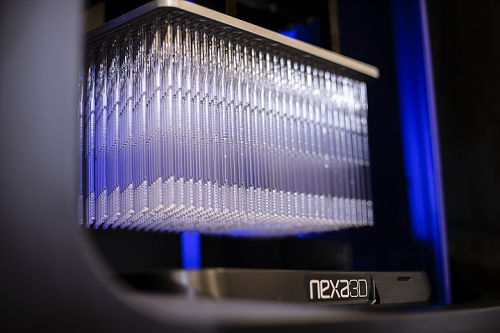 Nasal swabs
Nasal swabsRecently, SLA 3D printer manufacturer Nexa3D and functional additive materials supplier Henkel announced that they were partnering up to commercialize the polypropylene-like xMED412, a durable, high-impact material that can be used to 3D print biocompatible medical and wearable devices; in fact, it’s already been cleared to print nasal swabs. Now, the two are holding a virtual leadership forum on “Advances and Breakthroughs in 3D Printed Medical Equipment and Device Materials,” like xMED412. Topics to be discussed will include new possibilities for 3D printing medical equipment and devices, the benefits of using AM to fabricate these products, and the advantages additive manufacturing has over medical materials made with traditional manufacturing. Panelists will engage with attendees after the discussion in a live Q&A session.
“3D printing has introduced all kinds of new possibilities for developing stronger and lightweighted equipment but we’ve only scratched the surface of what’s possible. These past few months have driven the industry to new realms of creativity with the need to quickly deliver medical supplies, devices and materials. With new lightweight, sturdy materials designed to withstand impact, moisture and vibration, access to lower cost medical equipment is becoming more widely available thanks to 3D printing.”
Register here for the 45-minute virtual forum, which will take place on Tuesday, August 4th, at 1:30 pm EST.
SOLIDWORKS Design Solution Demonstration
Also on August 4th, at 11 am EST, Dassault Systèmes will be holding a brief demonstration of its 3DEXPERIENCE SOLIDWORKS design solution. This demonstration of the platform’s capabilities will last just 22 minutes, and will teach attendees how to collaborate and stay connected to data while creating new designs with SOLIDWORKS when connected to the 3DEXPERIENCE platform, exploring the latest tools available on the platform, and design a model using both parametric (3D Creator) and Sub-D modeling (3D Sculptor) tools with the help of complementary workflows.
“SOLIDWORKS is the design tool that has been trusted by engineers and designers around the world for decades. Part of the 3DEXPERIENCE WORKS portfolio, SOLIDWORKS is now connected to the 3DEXPERIENCE platform with cloud-based tools that enable everyone involved in product development to collaborate on real-time data. Doing so enables you to efficiently gain the insight needed to create revolutionary new products.”
You can register for the demonstration here.
NextFlex Innovation Days
The last August 4th event in this week’s roundup is NextFlex Innovation Days, the flagship showcase event for the consortium of academic institutions, companies, non-profits, and local and federal governments that make up NextFlex and are working to advance US manufacturing of flexible hybrid electronics (FHE). The event will run through Thursday, August 6th, and will include panel discussions on how FHEs are continuing to transform the world, including a panel featuring a special guest speaker from the US Senate. FHE innovations that will be highlighted during the event include a wearable biometrics monitor from Stretch Med, Inc., flexible skin-like sensors from Georgia Tech, a flexible UV sensor out of the NASA Ames Research Center, miniaturized gas sensors that GE Research integrated into wearables and drone formats, and Brewer Science’s integrated FHE solutions in a brewery application.
“This multi-day virtual event will feature over 50 customer, partner and member company presentations online available at no cost. If you watch live, you’ll have the chance to interact with presenters and flexible hybrid electronic (FHE) experts from the comfort of home via webinars and virtual labs, or you can watch video demonstrations at your availability.”
Register for NextFlex Innovation Days here.
Additive America & HP AM Webinar
HP is currently sponsoring a webinar series highlighting business in the AM industry that worked to transition their production processes in order to help fill the supply chain gap that’s been caused by the COVID-19 pandemic. This week’s episode, which will take place at 1:30 pm EST on Wednesday, August 5th, will feature a discussion with Additive America on “the lasting impact of COVID-19 on additive manufacturing.”
“Listen in on conversations with our customers to learn how they have adapted to the change in business climate, whether it be a shift in production workflow to address supply chain gaps, enabling a faster product development cycle to support changing customers’ needs, or bridge production.”
You can register for this webinar here.
Prodways, BASF, & Peridot Talk Polypropylene
Also on August 5th, Prodways, BASF, and full-service product development company Peridot Inc. will be holding a free webinar together called “Rethink Additive Manufacturing with Polypropylene.” Led by Lee Barbiasz from Prodways, Jeremy Vos from BASF, and Peridot owner Dave Hockemeyer, the webinar will focus on how PP 1200, a tough, chemically resistant, low density polypropylene enabled by BASF for selective laser sintering (SLS) 3D printing, is being used to bridge the gap between additive manufacturing and injection molding, as well as growing opportunities and applications in short run manufacturing. Hockemeyer was an early adopter of the material, and will share a variety of use cases for PP 1200. There will also be a chance for attendees to ask questions about the material.
“3D Printing with Polypropylene is here! After more than three decades, 3D printing technology has evolved the ability to 3D print polypropylene material. Polypropylene enables scalability in manufacturing, reduces barriers to entry in 3D printing and reduces manufacturing costs by 25-50%!”
You can register for the webinar, held on Wednesday, August 5th, from 1-1:45 pm EST, here.
KEX Knowledge Exchange on Market, Costs & Innovation
The last entry in this week’s roundup will take place on Thursday, August 6th. KEX Knowledge Exchange AG, a former spinoff of Fraunhofer IPT, held webinars in July about powder bed fusion technology and post-processing, and the last in its series will be an online seminar on Market, Costs & Innovation. Sebastian Pfestorf from KEX and Lea Eilert, the project and technology manager for the ACAM Aachen Center for Additive Manufacturing, will be the speakers for this webinar.
“In this online seminar, you will learn:
-
Current AM market and industrial trends
-
What markets the technology has penetrated the most and why
-
How to go about implementing AM, including risks and uncertainties
You can register for the hour-long webinar here. It will take place on Thursday, August 6th, at 8 am EST.
Will you attend any of these events and webinars, or have news to share about future ones? Let us know!
The post 3D Printing Webinar and Virtual Event Roundup, August 2, 2020 appeared first on 3DPrint.com | The Voice of 3D Printing / Additive Manufacturing.
3D Printing News Briefs, July 25, 2020: MakerBot, ANSYS, Sintavia, Nexa3D & Henkel
We’re all business in today’s 3D Printing News Briefs! MakerBot has a new distribution partner, and ANSYS is launching a new product. Sintavia has acquired an additional Arcam 3D printer from GE Additive. Finally, Nexa3D and Henkel are introducing a new material for 3D printing medical and athletic devices.
MakerBot Welcomes New Distribution Partner
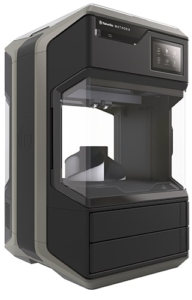 MakerBot announced that it has expanded its distributor network by entering into an agreement with the Distrinova division of the Unitum Group, which will distribute the MakerBot METHOD 3D print platform throughout Belgium, the Netherlands, and Luxembourg. This partnership will increase the availability of the entire platform, which offers industrial capabilities and engineering-grade materials, to more customers in the Benelux region who need professional, powerful 3D printing solutions. The METHOD platform consists of the METHOD and METHOD X printers, various accessories like an experimental extruder, METHOD Carbon Fiber editions, and materials like Nylon Carbon Fiber, ABS, ASA, SR-30, and PC-ABS FR, and Distrinova’s network of channel partners will distribute all of them, in addition to MakerBot’s educational 3D printing solutions.
MakerBot announced that it has expanded its distributor network by entering into an agreement with the Distrinova division of the Unitum Group, which will distribute the MakerBot METHOD 3D print platform throughout Belgium, the Netherlands, and Luxembourg. This partnership will increase the availability of the entire platform, which offers industrial capabilities and engineering-grade materials, to more customers in the Benelux region who need professional, powerful 3D printing solutions. The METHOD platform consists of the METHOD and METHOD X printers, various accessories like an experimental extruder, METHOD Carbon Fiber editions, and materials like Nylon Carbon Fiber, ABS, ASA, SR-30, and PC-ABS FR, and Distrinova’s network of channel partners will distribute all of them, in addition to MakerBot’s educational 3D printing solutions.
“We are very proud to introduce MakerBot and the METHOD technology into our product portfolio,” said Guy Van der Celen, CEO of Unitum Group BV. ” With the METHOD range we can provide our resellers network not only reliable, state-of-the-art 3D printers, but also the opportunity to offer their customers high value-added solutions for a broad range of new application areas. In addition, the introduction of MakerBot corresponds perfectly with Distrinovas’ strategy to develop strong partnerships with the leading innovative global manufacturers of 3D printers.”
ANSYS Event to Launch Discovery Product
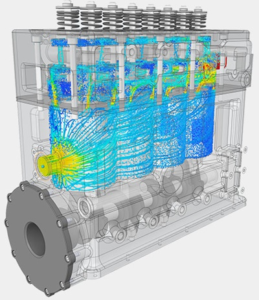 Engineering simulation software company ANSYS released its Discovery Live tool for real-time 3D simulation back in 2017, and will soon be introducing a brand new ANSYS Discovery product, kicking things off with a virtual launch event on July 29th. The company states that the product can help companies improve their product design processes, increase ROI, and provide answers to important design questions earlier, without having to wait for the results of a simulation.
Engineering simulation software company ANSYS released its Discovery Live tool for real-time 3D simulation back in 2017, and will soon be introducing a brand new ANSYS Discovery product, kicking things off with a virtual launch event on July 29th. The company states that the product can help companies improve their product design processes, increase ROI, and provide answers to important design questions earlier, without having to wait for the results of a simulation.
“This reimagining of the Discovery line of products aims to maximize ease of use, speed and accuracy across thermal, structural, fluids and multiphysics simulation all from within a single consistent user interface (UI),” Justin Hendrickson, Senior Director, Design Product Management, wrote in a blog post about the new ANSYS Discovery.
“Traditionally, simulation has been used during later stages of design when making corrections can be costly and time consuming. However, with the new Ansys Discovery, every engineer will be able to leverage simulation early during concept evaluation as well as during design refinement and optimization. This means that they will be able to optimize products and workflows faster and on a tighter budget.”
The launch event will feature a keynote address from Mark Hindsbo, Vice President and General Manager, Design Business Unit, a product demonstration by Hendrickson, two customer success stories, and several interactive breakout sessions, including one focusing on thermal simulation and another exploring the tool’s generative design capabilities. You can register for the event here.
Sintavia Acquires Second Arcam Q20+ 3D Printer
 Tier One metal additive manufacturer Sintavia announced that it has acquired a second Arcam Q20+ 3D metal printer from GE Additive, bringing its total number of electron beam printing systems to three and its overall number of industrial metal 3D printers to nineteen. This additional Arcam Q20+ will be installed next month in Sintavia’s Hollywood, Florida production facility, where the other Q20+ is located with an Arcam A2X, a Concept Laser M2, three SLM 280 systems, a Trumpf TruPrint 3000, and nine EOS 3D printers – six M400s and five M290s.
Tier One metal additive manufacturer Sintavia announced that it has acquired a second Arcam Q20+ 3D metal printer from GE Additive, bringing its total number of electron beam printing systems to three and its overall number of industrial metal 3D printers to nineteen. This additional Arcam Q20+ will be installed next month in Sintavia’s Hollywood, Florida production facility, where the other Q20+ is located with an Arcam A2X, a Concept Laser M2, three SLM 280 systems, a Trumpf TruPrint 3000, and nine EOS 3D printers – six M400s and five M290s.
“Over the past several years, we have worked to qualify the Q20+ for aerospace manufacturing and now have several aerostructure product lines that depend on this technology. Electron beam printing is an excellent option for complex titanium aerospace components, and this business line will continue to grow for us. Even in a difficult overall manufacturing environment, the demand we have seen for EB-built components is very encouraging,” stated Sintavia CEO Brian R. Neff.
Nexa3D and Henkel Commercializing New Material Together
Together, SLA production 3D printer manufacturer Nexa3D and functional additive materials supplier Henkel are commercializing the polypropylene-like xMED412, a durable, high-impact material that can be used to print biocompatible medical and wearable devices. Henkel is the one manufacturing the medical-grade material, which is based on its own Loctite MED412 and was designed to offer high functionality and consistent part performance—perfect for printing products like athletic and diving mouth gear, respirators, orthotic guides and braces, and personalized audio projects. The lightweight yet sturdy xMED412 material, which can withstand vibration, moisture, and impact, has been tested by Henkel Adhesive Technologies on the NXE400 3D printer, and is now also cleared to print nasal swabs.
“We are thrilled to bring this product to market in collaboration with Nexa3D. We developed and tested with Nexa3D’s NXE400 3D printer a multitude of approved workflows designed to unleash the full potential of xMED412’s outstanding physical properties and biocompatibility,” said Ken Kisner, Henkel’s Head of Innovation for 3D printing. “Nexa3D and Henkel have provided a digital manufacturing solution for a growing number of medical devices, athletic wearables and personalized audio products. Especially with regard to the current Covid-19 pandemic, we are pleased that nasopharyngeal swabs manufactured with xMED412 on the NXE400, in accordance with our published procedures, have already been cleared through clinical trials and are in compliance with ISO 10993 testing and FDA Class I Exempt classification.”
The post 3D Printing News Briefs, July 25, 2020: MakerBot, ANSYS, Sintavia, Nexa3D & Henkel appeared first on 3DPrint.com | The Voice of 3D Printing / Additive Manufacturing.
Renishaw launches latest 3D modeling software – FixtureBuilder 8.0
HOOPS and Proplanner Combine 3D Model Data and PLM to Realize Industry 4.0
Oregon company Tech Soft 3D, with offices also in California, England, France, and Japan, is a provider of engineering software development kits (SDKS) through its HOOPS Platform, and offers other tools, like Polygonica and Siemens Parasolid, that help software teams deliver successful applications in additive manufacturing.
Now, the company has announced that Proplanner, a PLM-MDM (Manufacturing Data Management for the Product Lifecycle) solutions provider, will be using HOOPS to integrate 3D model data into its Assembly Planner for data management and desktop, mobile, and web product planning and visualization.
Product data management (PDM) and product lifecycle management (PLM) are tools becoming increasingly adopted in the manufacturing world as means of more closely tying together various aspects of a production business. Rather than have disparate files, such as CAD and bill of materials, coming from disparate company departments, all of this data can be linked together, giving intended users access to all of the necessary information without having to manually contact each department to get specific data or files.
The Assembly Planner solution is used by manufacturing companies in a variety of industries, from automotive, aerospace, agriculture, and military to construction, medical device, electrical equipment, and academic. These manufacturers are often called on to fabricate complicated assemblies which are, according to a Tech Soft 3D press release, “often highly configured into customer orders.”
Users can work with Assembly Planner’s database to write and manage, in a secure location, their own manufacturing bill of materials (mBOM) and Bill of Process (BOP) routings. Then these companies can use the data to complete all sorts of helpful business tasks, such as auto-generating work instructions, balancing assembly lines, manage internal logistics, and complete time studies.
All of that is more complicated than it sounds. But by working with Tech Soft 3D and using its many SDKs, Proplanner can easily integrate 3D models into its Assembly Planner, and extract the underlying data. The company is using the HOOPS Platform to link process models and CAD models so that all of the data relates correctly.
“Linking the process model to the 3D model was the goal. We get a 3D model from one source, we get an eBOM from another source, which is the basis of our mBOM and we generate a BOP routing which consumes parts from that mBOM while visually manipulating the 3D model,” Proplanner’s President David Sly said. “Those three elements of the triangle (mBOM, BOP routing and 3D model) have to relate – and getting them to relate is really, really difficult when all three may be authored concurrently and independently for many variants, which is why most attempts in the past haven’t been successful.”
The HOOPS Platform has a lot to offer, like its HOOPS Communicator, a powerful but simple toolkit for creating advanced 3D web visualizations. HOOPS Exchange is meant to be a fast and accurate CAD data translation toolkit. It converts the source CAD file into an HSF or PRC format, and extracts detailed metadata, through a single interface, making it a simple workflow that negates the use of integration with PDM or PLM systems. HOOPS Publish enables applications to publish 3D data in multiple formats, including HTML, CAD, and native 3D PDF, and HOOPS Visualize is a graphics engine that can help teams create high performance applications.
Specifically, Proplanner is using HOOPS Communicator for the web version of its product, thanks to Tech Soft 3D’s HSF fast streaming format, while HOOPS Visualize is being applied for the Windows version. This collaboration has enabled the company to provide its customers with an easy-to-use workflow for bringing in 3D CAD models, without having to involve other systems. Working with the HOOPS Platform also means that Assembly Planner users can extract data from CAD models, easily visualize complex assemblies, and be the first to market with a way to solve a long-standing data management issue.
“3D is critical. 3D is what allows us to visually validate the process and generate shop floor instructions, but the knowledge that HOOPS Exchange is helping us extract from the CAD model is just as crucial. It helps us map the 3D model to the process, to convert the engineering change orders (ECOs) and engineering bill of materials (eBOMs) into manufacturing bill of materials (mBOMs), and associated process routings,” explained Sly.
“Some customers have tried to get this information to match up for decades and failed. The problem was that there was no way to easily reconcile the variances between a CAD model that might have thousands of parts with the other documents and data sources. Thanks to Tech Soft 3D, we’re at a point technologically now where customers can extract the data from many different CAD formats, and reconcile it against eBOMs and mBOMs and other data sources. The underlying technology from Tech Soft 3D is enabling all this information to finally come together.”

HOOPS Exchange allows development teams to easily build robust CAD data translation capabilities into their application, while HOOPS Visualize and HOOPS Communicator allow those 3D models to be visualized, on desktop and the web.
The use of PLM and PDM are increasingly considered necessary tools for the further digitization of manufacturing and realization of Industry 4.0. With 3D printing and other digital fabrication techniques thought of as the means for realizing 3D designs, PLM and PDM are now thought of as the software solutions for ensuring a continuous thread throughout the design-to-production process. For this reason, tools like Proplanner will gain greater importance in the world of 3D printing, just as 3D printing will gain greater importance in manufacturing overall.
(Images courtesy of Tech Soft 3D unless otherwise stated)
The post HOOPS and Proplanner Combine 3D Model Data and PLM to Realize Industry 4.0 appeared first on 3DPrint.com | The Voice of 3D Printing / Additive Manufacturing.

